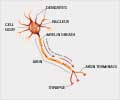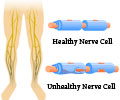An enzyme that plays a role in peripheral neuropathy induced by cancer chemotherapy also plays a role in peripheral neuropathy caused by diabetes.

‘The drug candidates to treat chemotherapy-induced peripheral neuropathy could potentially be used to treat peripheral neuropathy that is caused by diabetes as well.’





The significance of the identification of a common molecular mechanism is that many more patients could potentially benefit from drugs that target this mechanism. In earlier research, Rieger identified two drug candidates for the treatment of chemotherapy-induced peripheral neuropathy that she is seeking to move into human clinical trials.Peripheral neuropathy is a potentially disabling condition affecting up to 40 million Americans that causes, pain, tingling, and numbness in the hands and feet. Treatments exist for alleviating pain, but the development of treatments to prevent or reverse nerve degeneration has been stalled by a lack of understanding of the underlying mechanisms.
"This finding means that the drug candidates we have identified to treat chemotherapy-induced peripheral neuropathy could potentially be used to treat peripheral neuropathy that is caused by diabetes as well," Rieger said.
"Peripheral neuropathy is a major and growing health problem," said Kevin Strange, Ph.D., president of the MDI Biological Laboratory. "The identification of the mechanism underlying glucose-induced peripheral neuropathy means that millions of patients could potentially benefit from the development of drugs that influence this pathway."
In previous research in zebrafish, Rieger identified two compounds that prevent and reverse peripheral neuropathy caused by exposure to Taxol, or paclitaxel, a common cancer chemotherapy agent. The compounds are the subject of a pending patent originally filed in 2016 by the MDI Biological Laboratory.
Advertisement
"The fact that this compound works in two such disparate species makes it more likely it will work in humans too," Rieger noted.
Advertisement
In her previous research on chemotherapy-induced peripheral neuropathy, Rieger linked the development of peripheral neuropathy in the zebrafish tailfin, which is analogous to a human extremity, to an increase in MMP-13 (matrix metalloproteinase-13), an enzyme that breaks down the collagen or "glue" that binds skin cells together.
Rieger believes this breakdown leads to the degeneration of the long, threadlike sensory nerve endings that innervate the skin. The degeneration of these nerve endings, which convey sensory information like temperature, pain and mechanical stimulation to the central nervous system, is responsible for the symptoms of peripheral neuropathy.
In the recent study of glucose-induced peripheral neuropathy, Rieger found that the same pathway is involved. She also found that reactive oxygen species (ROS), which can cause tissue damage, play a role in the process. The formation of ROS, which (also known as oxidative stress) is a hallmark of diabetes.
Rieger found that ROS are the cause of the increased MMP-13 activity, and that increased MMP-13 activation and nerve damage can be prevented by the pharmacological inhibition of ROS with an anti-oxidant compound.
One of the goals of the study was to develop a zebrafish model to study glucose-induced peripheral neuropathy. Rieger will use the new model to delve more deeply into the mechanisms underlying glucose-induced peripheral neuropathy and to identify more effective variants of the drug candidates she has discovered.
Larval zebrafish are used as a model because their translucency allows scientists to easily track nerve degeneration in live animals.
Source-Eurekalert















